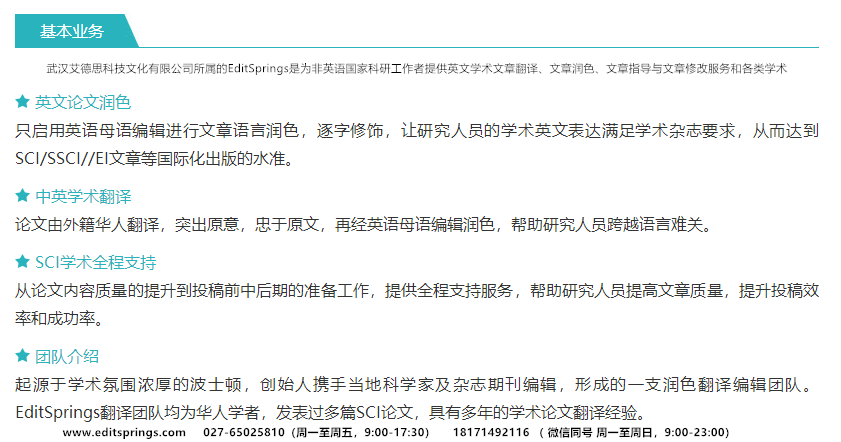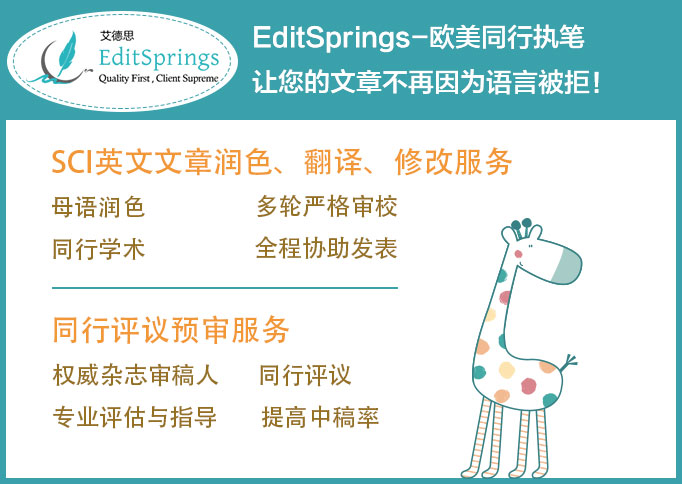来自美国波士顿

微信扫码关注公众号进行登录


完善安全信息
为了您的账号安全,请完善以下信息


来自美国波士顿
更专业的论文润色机构
微信扫码登录
微信扫码关注公众号进行登录


来自美国波士顿
更专业的论文润色机构
手机验证码登录
账号密码登录
微信扫码登录
微信扫码关注公众号进行登录
怎么写SCI论文的Discussion部分,EditSprings艾德思SCI学术论文服务,SCI论文润色,SCI论文翻译等服务

众所周知,讨论部分是在结合自己的研究结果基础上,对整个文章的结论的提炼和升华。这一部分是整个论文的精,往往点睛作用。 同时,很多杂志要求结果和讨论分开,这也就更突出了写好讨论的重要性。 那么,我们应该怎样写好讨论部分呢? 下面EditSprings艾德思借助Jim Hesson and Eveline Farias-Hesson 的资料来逐步讲解: general outline of a discussion: ?Beginning the Discussion ?Middle of the Discussion ?Taking Credit For Accomplishments of the Study ?Indicating the Novelty of the Study ?Noting Similarity in Findings ?Noting Differences in Findings ?Explaining Why Certain Results Were Obtained ?Concluding the Discussion ?Discussing Limitations ?Possible Applications of the Findings ?A Call for Future Studies ?Concluding Statement 上面是开始写讨论之前的需要思考的问题,在进行每一部分之前,初级写手需要注意区分结果和讨论的区别:一个主要的区别 The discussion section is that it is characterized by a series of points, rather than facts as in the results section (Swales and Feaks, 2004). These points are interpretive rather than descriptive as in the factual reporting in the results section。 根据以上的区分,我们可以认为讨论就是“解释性的,或者说明性的阐述几个观点”,讨论的另一个显著特点是: Compared to the results section, it tends to be: more abstract, general, theoretical, related to the real world, concerned with practical applications and implications, as well as engaged in dialogue with the larger field of study (Swales and Feaks, 2004). The discussion section is where you will draw out, delineate and consolidate the meaning of the results, as well as tactfully dialogue with the broader community of your field and attempt to build community consensus on the meaning of your findings (Swales and Feaks, 2004) 以上的表述说明,讨论部分要和研究结果联系起来,作者不能“天马行空”论述一些和自己的研究结果联系不太大,或者是牵强的理论或者观点。和研究结果的具体,特定,并且量化的特点比较起来,讨论部分应该体现出对研究结果更普遍的注解或者评论,所以讨论中每一个部分往往以陈述作者自己的发现开始: in general, (over all, on average, by and large, on the whole, etc.) we found that.......... 对于整个讨论,或者说讨论的每一个独立的部分,: it may be helpful to think of the discussion as a story, and like other clear and coherent stories, the discussion has a beginning, middle and end (Zeiger, 1999)。 开始: In the beginning of the story, you will introduce the reader to your original purpose, and then name your major findings and present results that support these findings. 中间部分: In the middle, you may show how other work supports your findings; report unexpected results; report on the novelty of the your work; explain conflicting results; suggest why your results are the way they are; explain how results of other studies do not agree with your findings, as well as defending your proposed answer against other possible answers to your main research question. 最后: At the end of the story, you may also discuss the limits of the method and validity of the assumptions as well as describing applications or implications of your findings. 以上就是很概括的描述了写一个讨论部分需要“keep in mind” 的概念。希望对我们写好英语论文都有点帮助。
更多科研论文服务,动动手指,请戳 论文润色、投稿期刊推荐、论文翻译润色、论文指导及修改、论文预审!
语言不过关被拒?美国EditSprings--专业英语论文润色翻译修改服务专家帮您!


特别声明:本文转载仅仅是出于传播信息的需要,并不意味着代表本网站观点或证实其内容的真实性;如其他媒体、网站或个人从本网站转载使用,须保留本网站注明的“来源”,并自负版权等法律责任;作者如果不希望被转载或者联系转载稿费等事宜,请与我们接洽。
凡注明来源为“EditSprings”的论文,如需转载,请注明来源EditSprings并附上论文链接。













 鄂公网安备:
鄂公网安备: